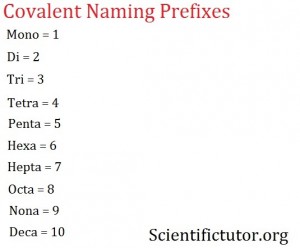Scientific Tutor
Chem – Naming Covalent Compounds Part 2
What sections should I know before attempting to learn this section?
—> Covalent, Ionic, and Metallic Bonds
How do you use a covalent (molecular) name to create the covalent compound?
Now that we have taken the covalent chemical compound and produced the chemical name (as we did in the previous section) we should try the other direction. That is taking the chemical name and producing the chemical compound. Remember to use the covalent prefixes from the picture below.
Examples: Give the chemical formula from the name using a regular periodic table and the covalent prefixes. VIDEO Covalent Naming Examples 2.
| Triboron Tetracarbide | B3C4 |
| Nitrogen Trifluoride | NF3 |
| Heptasulfur Diselenide | S7Se2 |
| Bromine Monochloride | BrCl |
VIDEO Covalent (Molecular) Naming Demonstrated Example 2: Give the chemical formula from the name using a regular periodic table and the covalent prefixes.
Pentaphosphorus Dibromide
Step 1:
What does the prefix “penta” mean?
Answer: 5
Step 2:
What is the symbol for phosphorus?
Answer: P
Step 3:
How much phosphorus do you have?
Answer: 5
Step 4:
What does “di” mean?
Answer: 2
Step 5:
What element does bromide refer to?
Answer: Bromine
Step 6:
What is the symbol for bromine?
Answer: Br
Step 7:
How much bromine do you have?
Answer: 2
Step 8:
What is the chemical formula?
COMPLETE ANSWER: P5Br2
PRACTICE PROBLEMS: Give the chemical formula from the name using a regular periodic table and the covalent prefixes.
| Silicone Tetrahydride | SiH4 |
| Diarsenic Hexasulfide | As2S6 |
| Trinitrogen Heptaoxide | N3O7 |
| Octaphosphorus Nonaxenide | P8Xe9 |

